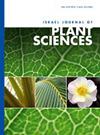The impact of Acacia saligna and the loss of mobile dunes on rodent populations: a case study in the Ashdod-Nizzanim sands in Israel
IF 0.9
4区 生物学
Q4 PLANT SCIENCES
引用次数: 4
Abstract
The Mediterranean coastal dune habitat of Israel is diminishing rapidly, mostly due to massive urbanization, changes in habitat characteristics caused by dune stabilization and the presence of Acacia saligna, an invasive species brought to Israel for the purpose of dune stabilization. In this study we document the effect of sand stabilization on the composition of small mammal communities in the Ashdod-Nizzanim sands, Israel. We analyzed differences in species diversity and abundance for species of rodents in four types of habitat: unstable (mobile) sand dune, semi-stabilized dune, inter-dune depression and a plot of the invasive Acacia saligna. Rodent communities were found to undergo gradual changes concurrently with the stabilization of the sands. The mobile dune was the only habitat in which the strict psammophiles Jaculus jaculus and Gerbillus pyramidum were captured in abundance. No species commensal with human were captured neither in the mobile nor in the semi-stabilized dunes. However, in the inter-dune depression there was quite a large representation of Mus musculus, a rodent commensal with humans. The Acacia saligna plot had the lowest number of captures and the lowest rodent biomass calculated, with Mus musculus composing nearly half of the captures. The results of this study demonstrate that stabilization of the sands in Ashdod-Nizzanim area is associated with the disappearance of psammophile rodents and the appearance of species commensal with humans. In order to preserve the habitat for psammophile rodents, measures should be taken to halt the spread of acacia and the continuing stabilization of the sands.唾液Acacia saligna和流动沙丘的丧失对啮齿动物种群的影响:以色列Ashdod Nizzanim沙漠的一个案例研究
以色列地中海沿岸沙丘栖息地正在迅速减少,这主要是由于大规模的城市化、沙丘稳定导致的栖息地特征变化,以及为稳定沙丘而带到以色列的入侵物种唾液Acacia saligna的存在。在这项研究中,我们记录了沙子稳定对以色列阿什杜德-尼扎尼姆沙子中小型哺乳动物群落组成的影响。我们分析了四种生境中啮齿动物物种多样性和丰度的差异:不稳定(流动)沙丘、半稳定沙丘、沙丘间洼地和入侵性唾液Acacia saligna地块。啮齿动物群落在沙子稳定的同时也发生了逐渐的变化。流动沙丘是唯一的栖息地,在那里,严格的嗜沙虫Jaculus Jaculus和Gerbillus pyramidum被大量捕获。无论是在流动沙丘还是半稳定沙丘中,都没有捕捉到与人类共生的物种。然而,在沙丘间洼地,有相当多的肌肉鼠,一种与人类共生的啮齿动物。Acacia saligna地块的捕获次数最低,啮齿动物生物量最低,其中Mus musculus占捕获量的近一半。这项研究的结果表明,Ashdod Nizzanim地区沙子的稳定与亲沙鼠的消失以及与人类共生的物种的出现有关。为了保护亲沙鼠的栖息地,应采取措施阻止金合欢树的传播和沙子的持续稳定。
本文章由计算机程序翻译,如有差异,请以英文原文为准。
求助全文
约1分钟内获得全文
求助全文
来源期刊

Israel Journal of Plant Sciences
生物-植物科学
CiteScore
1.90
自引率
0.00%
发文量
17
审稿时长
>12 weeks
期刊介绍:
The Israel Journal of Plant Sciences is an international journal of extensive scope that publishes special issues dealing with all aspects of plant sciences, including but not limited to: physiology, cell biology, development, botany, genetic
 求助内容:
求助内容: 应助结果提醒方式:
应助结果提醒方式:


